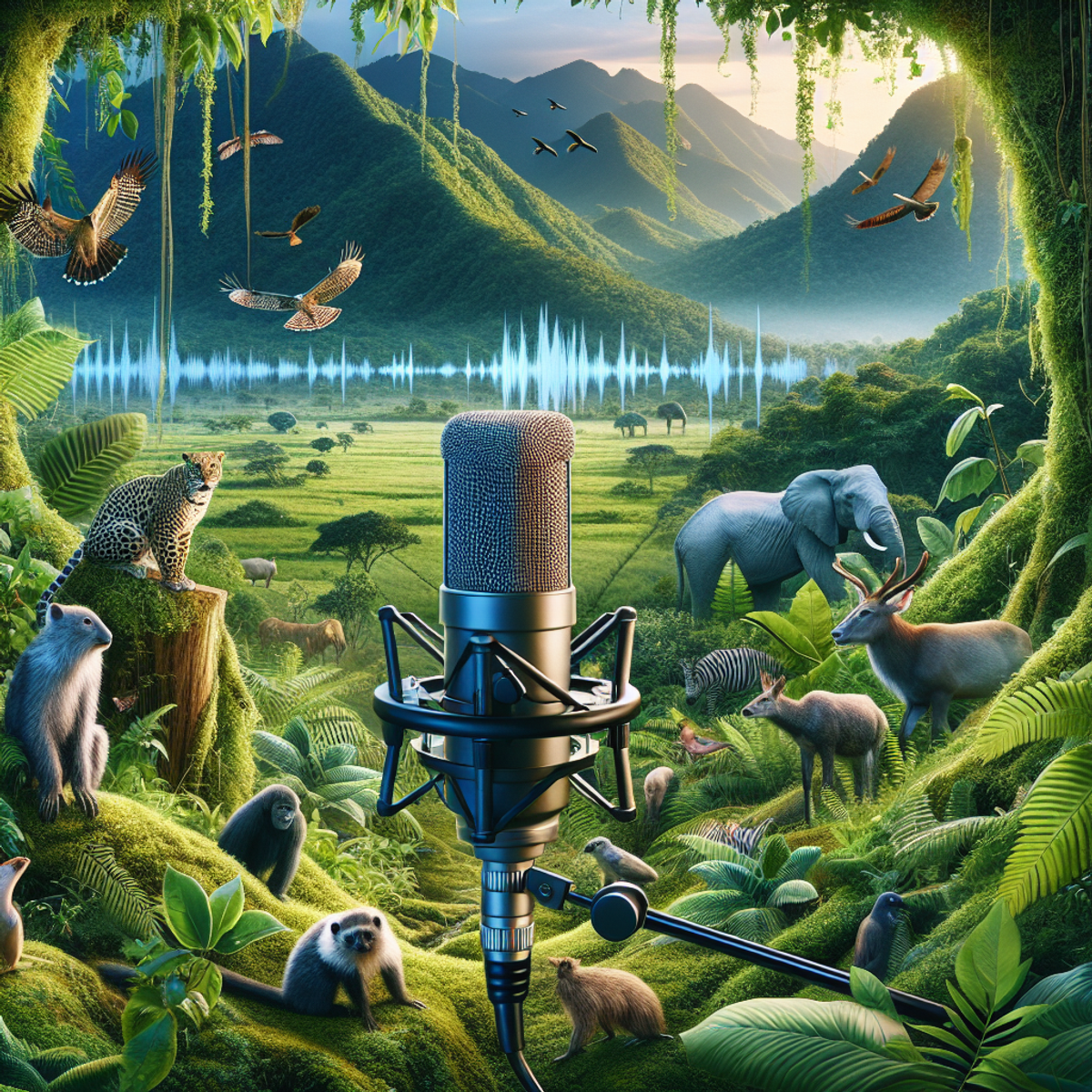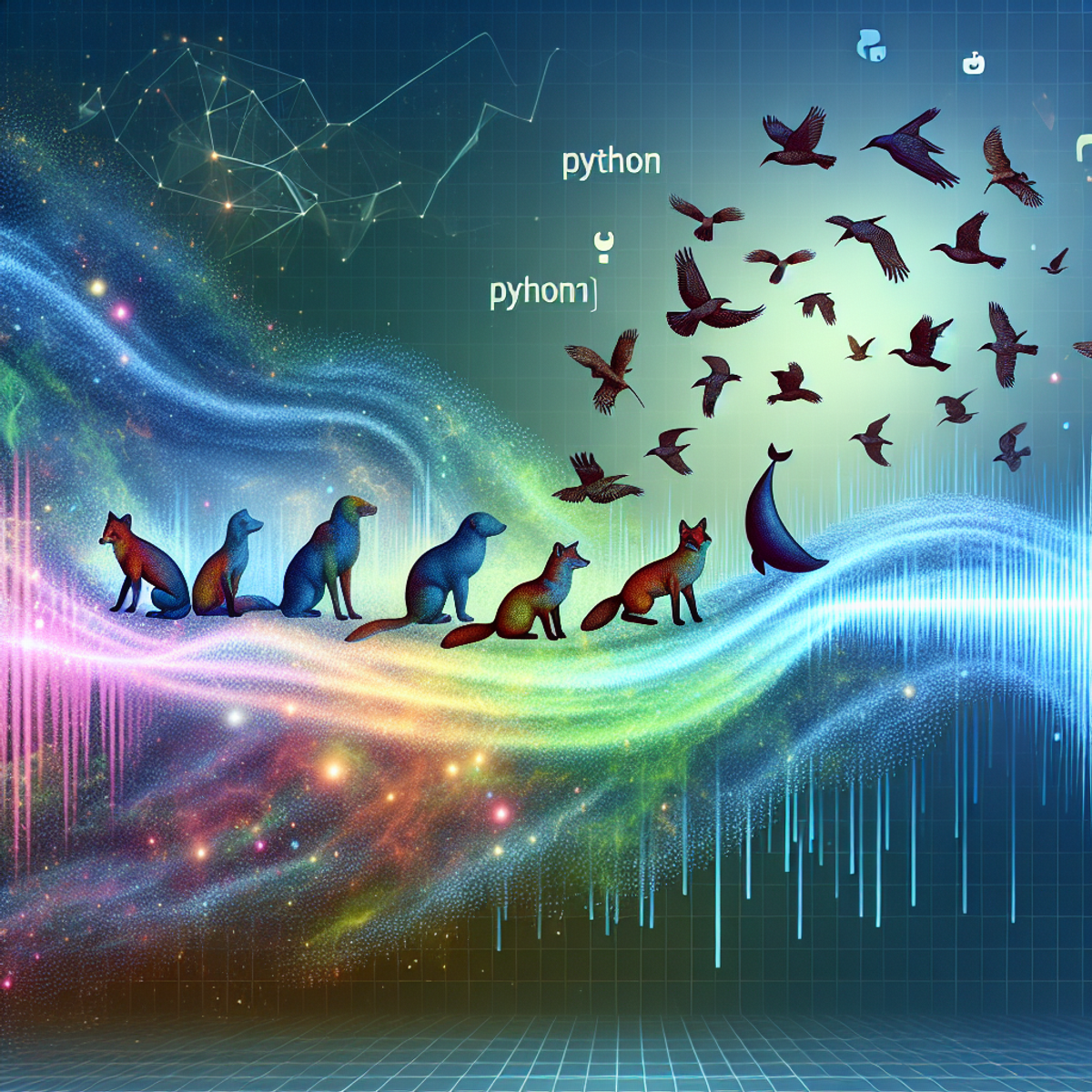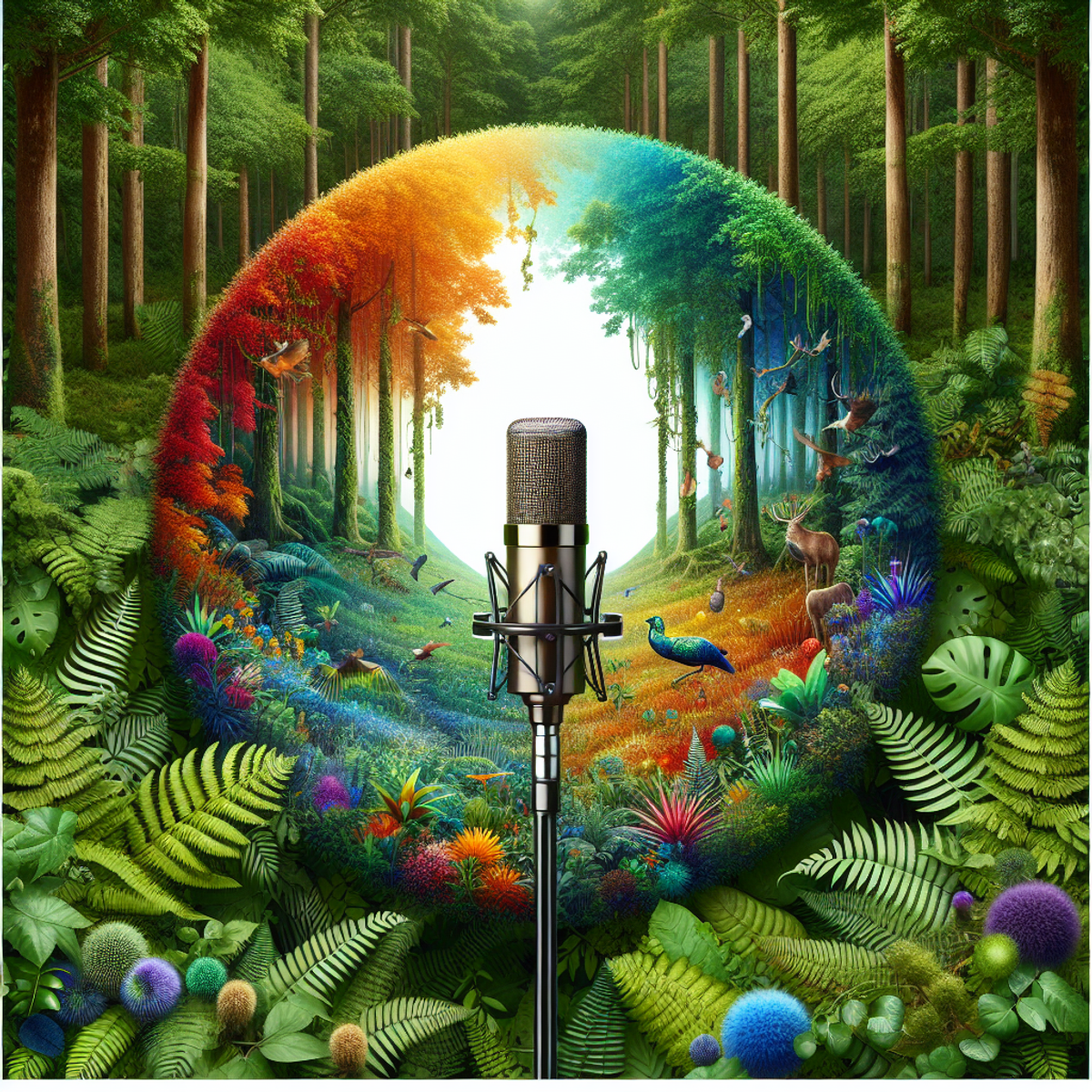Python and Bioacoustics: Wildlife Monitoring

Python and Bioacoustics: Wildlife Monitoring
Introduction
Bioacoustics is a fascinating field that involves the study of sound production, dispersion, and reception in animals. By utilizing technology to monitor and analyze wildlife vocalizations, bioacoustics plays a crucial role in various aspects of wildlife monitoring, species identification, and biodiversity assessment. In recent years, Python has emerged as a powerful tool for advancing bioacoustics research and has revolutionized the way we approach wildlife monitoring.
Python, a versatile programming language, offers a wide range of libraries and frameworks that facilitate data analysis, signal processing, and machine learning applications. Its flexibility and ease of use make it an ideal choice for researchers working in the field of bioacoustics. The integration of Python and bioacoustics enables scientists to develop automated systems for wildlife monitoring, species identification, and long-term biodiversity assessment.
In this article, we will explore the intersection of Python and bioacoustics specifically in the context of wildlife monitoring. We will delve into the various applications of Python in bioacoustics research and discuss its impact on conservation efforts and ecological understanding.
But before we dive into the details, let's first understand what bioacoustics entails and why it is relevant in the realm of wildlife monitoring.
Understanding Bioacoustics
Bioacoustics is not just about the sounds animals make; it is about deciphering the messages encoded within those sounds. Animals produce vocalizations for various purposes such as communication, mate attraction, territorial defense, and navigation. These vocalizations contain valuable information that can be used to identify species, track individual animals, assess population health, and monitor ecosystem dynamics.
Understanding bioacoustics requires knowledge about how animals produce sounds and how sound waves behave in different environments. For example, certain species have unique vocalization patterns or frequencies that can be used to identify them accurately. By studying these patterns and utilizing Python's libraries for audio analysis, researchers can create algorithms that automatically detect and classify different species based on their vocalizations.
The Role of Python in Bioacoustics
Python also plays a crucial role in analyzing bioacoustic data to gain insights into ecosystem health. By applying advanced signal processing techniques, researchers can extract meaningful information from acoustic recordings. Python's libraries for data analysis and visualization enable scientists to process large volumes of acoustic data efficiently, leading to a better understanding of species distribution, population dynamics, and habitat quality.
Developing automated systems for wildlife monitoring using Python presents both challenges and opportunities. On one hand, Python's flexibility allows for the creation of sophisticated algorithms that can detect and classify species accurately. On the other hand, challenges arise in terms of noise interference, variability in vocalizations, and the need for robust field-deployable recording systems.
Looking ahead, there are exciting possibilities for integrating artificial intelligence algorithms into Python-based tools for enhanced species detection and monitoring. By leveraging machine learning techniques, researchers can train models to identify new or rare species based on limited data, contributing to our knowledge of biodiversity and aiding conservation efforts.
Throughout this article, we will explore case studies showcasing successful projects that leverage Python in various areas of bioacoustic research. From species conservation to ecosystem monitoring, these examples demonstrate the power of Python in advancing our understanding of wildlife and its role in ecological processes.
Python and Bioacoustics
Python, a versatile programming language, has emerged as a powerful tool in the field of bioacoustics. Its extensive library ecosystem, ease of use, and flexibility make it an ideal choice for researchers and conservationists involved in wildlife monitoring through bioacoustic analysis. In this section, we will explore the various ways Python contributes to the advancement of bioacoustics research.
Data Analysis and Visualization
Python provides a wide range of libraries for data analysis and visualization, which are essential in bioacoustics research. Some notable libraries include:
- NumPy: A fundamental package for scientific computing that enables efficient handling of large multidimensional arrays and mathematical operations.
- Pandas: A library for data manipulation and analysis, offering powerful tools for data cleaning, transformation, and exploration.
- Matplotlib: A comprehensive plotting library that allows researchers to create various visualizations, such as spectrograms and waveforms.
These libraries enable researchers to process and analyze bioacoustic data efficiently, extracting valuable insights about species vocalizations and their patterns over time.
Signal Processing
Python offers a range of signal processing libraries that facilitate the extraction of meaningful information from acoustic recordings. Some popular libraries include:
- Librosa: Primarily used for music information retrieval tasks, Librosa's functionality extends to bioacoustics research. It provides tools for feature extraction from audio signals, allowing researchers to analyze specific characteristics of animal vocalizations.
- SciPy: An open-source library that covers various scientific computing domains, including signal processing. SciPy offers functions for filtering, Fourier analysis, and spectral estimation.
- TextGridTools: A toolkit for processing and analyzing TextGrid files, which are commonly used in phonetics and linguistics research. This toolkit can be adapted for bioacoustics studies involving TextGrid files.
By leveraging these libraries, researchers can apply advanced signal processing techniques to identify specific sounds, measure acoustic parameters, and classify different species based on their vocalizations.
Machine Learning
Machine learning algorithms have gained significant popularity in bioacoustic research due to their ability to automate species identification and classification tasks. Python's machine learning libraries, such as scikit-learn and TensorFlow, provide researchers with powerful tools for developing and implementing these algorithms.
By training models on labeled bioacoustic data, researchers can create automated systems that accurately identify species based on their vocalizations. This enables efficient monitoring of wildlife populations and aids in conservation efforts.
Integration with Hardware
Python's versatility extends beyond data analysis and processing. It can also be used to interface with hardware, making it suitable for developing custom bioacoustic monitoring systems. For example:
- Raspberry Pi: Python is the preferred language for programming Raspberry Pi, a popular single-board computer. Researchers can use Python to control microphones, record audio, and process the acoustic data directly on the device.
- Arduino: Python can communicate with Arduino boards, allowing researchers to integrate various sensors (e.g., temperature, humidity) into bioacoustic monitoring systems.
This integration of Python with hardware provides researchers with the flexibility to design and deploy cost-effective
Python and Bioacoustics: Wildlife Monitoring
Python plays a crucial role in transforming bioacoustic research for wildlife monitoring. This programming language empowers researchers and conservationists to analyze acoustic data and uncover valuable insights about wildlife populations and their habitats.
Species Identification Techniques
One of the main applications of Python in bioacoustics for wildlife monitoring is species identification. By using machine learning algorithms and audio recordings, researchers can create automated systems that accurately distinguish between different animal species based on their sounds. Python libraries like Librosa and TensorFlow provide the necessary tools and frameworks for implementing these techniques.
- Species identification using machine learning algorithms
- Automated systems based on audio recordings
- Python libraries: Librosa, TensorFlow
Example: The Cornell Lab of Ornithology's Merlin Bird ID project uses Python-based machine learning algorithms to identify bird species from recordings. This project has been incredibly valuable for citizen science initiatives, allowing anyone to contribute to bird conservation efforts by submitting audio recordings for analysis.
Understanding Ecosystem Health
Analyzing bioacoustic data is essential for comprehending ecosystem health and biodiversity. Python enables researchers to extract meaningful information from sound recordings, assisting them in tracking changes in wildlife populations over time.
With Python, researchers can utilize advanced techniques to:
- Detect specific sounds or behaviors indicating ecological disruptions through signal processing
- Assess the impact of human activities, climate change, or other factors on animal populations by analyzing acoustic data from different locations and time periods
Case Example: Whale Song Analysis
An excellent case study showcasing Python's utility in bioacoustic research is the analysis of whale songs. These complex vocalizations are vital for communication and mating rituals among whale populations. Python libraries like Pandas and Matplotlib enable researchers to visualize and analyze long-term datasets of whale song recordings.
By applying computational methods to these datasets, scientists have discovered patterns in whale songs that vary across different regions and seasons. This information helps monitor changes in population size, migration patterns, and overall health of whale species.
Challenges and Opportunities
While Python provides powerful tools for automated wildlife monitoring, there are challenges that researchers face in implementing these systems. One significant hurdle is the need for extensive training data to develop accurate machine learning models. Collecting and labeling large amounts of audio recordings can be time-consuming and resource-intensive.
However, as technology advances, there are opportunities to overcome these challenges. For instance, the integration of artificial intelligence algorithms in Python-based tools can enhance species detection capabilities. By training models with vast datasets, these systems can continually improve accuracy and efficiency.
The Future of Python and Bioacoustic Research
The collaboration between the Python community and the field of bioacoustics holds immense potential for advancing wildlife conservation efforts. As Python continues to evolve and new libraries are developed specifically for bioacoustics research, we can expect even more sophisticated tools and techniques to emerge.
By harnessing the power of Python's data analysis capabilities, researchers can gain a deeper understanding of animal sounds, monitor ecosystem health more effectively, and contribute to biodiversity conservation on a global scale.
Understanding Bioacoustics
Bioacoustics is a fascinating field that involves the study of sound production, dispersion, and reception in animals. By examining the sounds made by different species, researchers can gain valuable insights into their behavior, communication methods, and ecological roles. In the context of wildlife monitoring, understanding bioacoustics is crucial for effectively utilizing Python to analyze and interpret acoustic data.
1. Sound Production
Animals produce sounds for various purposes, including communication, mate attraction, territorial defense, and navigation. Different species have evolved unique mechanisms for sound production. For example:
- Birds use specialized vocal organs called syrinxes to produce complex songs and calls.
- Marine mammals like dolphins and whales generate sounds through specialized air sacs and nasal passages.
By studying the specific characteristics of these sounds, researchers can:
- Identify species
- Track their movements
- Assess individual health and reproductive status
2. Dispersion of Sound Waves
Sound waves behave differently in different environments, such as air, water, or solid structures. Understanding how sound waves propagate through these mediums is essential for accurate analysis of bioacoustic data. For instance:
- Water acts as an excellent conductor of sound due to its higher density compared to air. This property allows marine animals to communicate over long distances using low-frequency sounds.
- Terrestrial animals need to adjust their vocalizations to overcome obstacles like vegetation or rugged terrain.
3. Reception of Sound
Animals have specialized sensory organs that enable them to receive and interpret sounds from their surroundings. Mammals typically possess highly sensitive ears that can detect a wide range of frequencies. Some species even have the ability to localize sounds with remarkable precision by using the time difference at which sound reaches each ear. Birds also have well-developed hearing abilities but rely more on visual cues for communication.
Understanding bioacoustics is crucial for wildlife monitoring because it provides a foundation for interpreting the acoustic signals captured by recording devices. By studying the sound production, dispersion, and reception mechanisms of different species, researchers can:
- Design effective monitoring protocols
- Develop algorithms for automated analysis using Python
Example Application: Bird Species Identification
In a study on bird species identification, researchers may analyze the unique vocalizations produced by each species. By examining the frequency range, duration, and pattern of these vocalizations, they can train machine learning models in Python to accurately classify and differentiate between various bird species. This allows for efficient monitoring of avian populations in remote areas where direct visual observations may be challenging.
Example Application: Underwater Bioacoustic Studies
Understanding the behavior of sound waves in different environments is also crucial for bioacoustic studies. For instance, when analyzing underwater recordings, researchers need to consider factors such as water temperature, salinity, and depth that can affect sound propagation. By accounting for these variables and using Python libraries like scipy or pandas, researchers can enhance the accuracy of their acoustic analyses and extract meaningful information from underwater recordings.
This knowledge forms the basis for developing advanced signal processing techniques, species identification algorithms, and automated monitoring systems that contribute to conservation efforts and ecological research.
Applications of Python in Bioacoustics for Wildlife Monitoring
Python, known for its versatility and wide range of libraries, has had a significant impact on bioacoustics research, especially when it comes to wildlife monitoring. Let's explore the many ways Python is used in this field:
1. Species Identification Techniques
Python is a powerful tool for identifying species in conservation projects. By using machine learning algorithms and signal processing techniques, researchers can create strong models for automated species recognition. For example, Python-based acoustic monitoring systems have allowed scientists to tell apart different bird species based on their sounds. This not only speeds up the process of analyzing data but also improves the accuracy of species identification, which is crucial for effective wildlife monitoring.
2. Role in Bioacoustic Data Analysis
Analyzing bioacoustic data is key to understanding the health of ecosystems and uncovering complex patterns within natural habitats. Python's wide range of libraries and frameworks makes this analysis much easier. For instance, researchers can use Python-based tools for visualizing data and packages for statistical analysis to gain valuable insights from large amounts of sound-related data. By using Python, we can process and understand biodiversity changes more effectively.
3. Utilization for Advanced Signal Processing
Python enables researchers to use advanced methods of processing signals to extract meaningful information from sound recordings. With Python libraries like SciPy and Pydub that focus on signal processing, we can break down and analyze complex audio signals with great accuracy. Additionally, Python's flexibility allows us to create custom signal processing algorithms that are tailored to our specific research needs. This adaptability is crucial in discovering subtle sound cues that contribute to comprehensive wildlife monitoring efforts.
Overall, Python's strengths are evident in various aspects of bioacoustics for wildlife monitoring, ranging from identifying species to analyzing data and processing signals. Its smooth integration with bioacoustics not only speeds up research but also encourages new ideas in conservation methods. As we explore the connections between Python and bioacoustics, it's clear that this combination has great potential for transforming wildlife monitoring efforts.
Challenges and Opportunities in Automated Wildlife Monitoring with Python
Acoustic data analysis and the monitoring of natural environments present both challenges and opportunities for the development of automated systems using Python. Let's delve into the intricacies of this dynamic field.
Benefits and Challenges of Automated Systems
Developing automated systems for wildlife monitoring using Python offers numerous benefits, such as:
- Efficiency: Automation allows for continuous data collection and processing, reducing the need for manual intervention.
- Real-time Monitoring: Automated systems enable real-time surveillance of wildlife activities, providing valuable insights into behavioral patterns and ecological dynamics.
- Data Volume Management: Python-based automation helps manage large volumes of acoustic data by streamlining the analysis process.
However, several challenges accompany the development of automated wildlife monitoring systems:
- Complexity: Designing effective automated systems requires addressing the complexity of natural environments and diverse wildlife habitats.
- Algorithm Accuracy: Ensuring the accuracy and reliability of algorithms for species detection and classification is a continual challenge in automated wildlife monitoring.
- Environmental Variability: Natural environments present variable acoustic conditions that can affect the performance of automated monitoring systems. For instance, this study discusses the impact of environmental variability on bioacoustic monitoring.
Future Possibilities
Looking ahead, there are exciting possibilities for advancing automated wildlife monitoring with Python:
- Artificial Intelligence Integration: The integration of artificial intelligence (AI) algorithms in Python-based tools holds great promise for enhancing species detection capabilities. Machine learning techniques can be utilized to train models on large datasets, improving the accuracy of species identification in diverse acoustic environments. This research paper explores the potential of AI integration in wildlife monitoring.
- Behavioral Pattern Recognition: Leveraging AI algorithms in bioacoustic studies can enable the recognition of complex behavioral patterns within wildlife vocalizations. This opens doors to a deeper understanding of animal communication and social dynamics, as discussed in this insightful LinkedIn article.
The intersection of Python programming, bioacoustics, and automated wildlife monitoring presents a rich landscape of challenges and opportunities. As technology continues to advance, so too will our ability to monitor and protect the natural world through innovative applications of sound analysis.
Case Studies: Python in Action for Bioacoustics Research
Case Study 1: Species Conservation
In a project focused on the conservation of endangered bird species, Python was used to analyze acoustic recordings collected from remote habitats. The researchers created custom algorithms to identify and classify different vocalizations of the target bird species. By using Python's extensive libraries for signal processing and machine learning, the team successfully automated the identification process, allowing them to monitor population trends and distribution patterns more efficiently.
Case Study 2: Ecosystem Monitoring
A research initiative aimed at assessing the health of marine ecosystems used Python to process hydrophone recordings from underwater environments. Through Python's strong signal processing capabilities, the research team extracted valuable acoustic features to understand the biodiversity and activity levels of marine organisms. This method provided a non-intrusive way to monitor ecosystems, giving insights into how marine species change over time and where they are found.
Case Study 3: Bioacoustic Data Visualization
In a collaborative project between wildlife biologists and data visualization experts, Python played a key role in creating interactive tools for exploring bioacoustic data. By combining Python with web development frameworks, the team made user-friendly interfaces that allowed people to see and understand complex acoustic information. These visualization tools made it easier for everyone involved to make decisions together and get more people interested in protecting wildlife.
Case Study 4: Automated Species Identification
A groundbreaking study in automated species identification used Python's machine learning abilities to create an advanced system for recognizing different animal sounds. By teaching convolutional neural networks with large sets of bioacoustic data, the researchers achieved impressive accuracy in identifying multiple species based on their unique vocal patterns. This method showed how Python-based solutions can completely change how we monitor species on a large scale.
Case Study 5: Community-Based Bioacoustic Monitoring
A community-led bioacoustic monitoring program took advantage of the accessibility and flexibility of Python to get citizen scientists involved in recording and studying wildlife sounds. By sharing free educational materials and resources, the program gave volunteers the tools they needed to contribute to biodiversity assessments using affordable recording devices and Python-based analysis tools. The collaborative efforts resulted in comprehensive collections of acoustic data that supported local conservation actions and environmental education programs.
These case studies show how Python is a flexible and powerful tool in different areas of bioacoustics research. From improving species conservation efforts to getting communities involved in wildlife monitoring, the use of Python has made bioacoustic studies better, leading to new ways of understanding and protecting natural ecosystems.
The Way Forward: Advancing Conservation through Python and Bioacoustics
The potential impact of continued collaboration between the Python community and the bioacoustics field on wildlife conservation efforts and ecological understanding is immense. By harnessing the power of Python in bioacoustics research, we can further advance our knowledge of the natural world and contribute to the conservation of biodiversity.
Key Points to Consider
1. Leveraging Python for Enhanced Conservation Efforts
The integration of Python and bioacoustics provides researchers with a powerful toolset to address conservation challenges. By automating species monitoring and identification processes, Python enables efficient data analysis and facilitates real-time decision making. For example, researchers can develop Python-based algorithms to detect and classify vocalizations from endangered species, helping prioritize conservation actions.
2. Collaboration for Ecological Understanding
Collaboration between the Python community and bioacoustics researchers fosters interdisciplinary approaches to ecological research. By combining expertise in programming, acoustics, and ecology, we can gain a deeper understanding of ecosystems' acoustic dynamics and their implications for biodiversity. This collaboration allows us to explore new avenues for studying animal behavior, population dynamics, and the impacts of human activities on wildlife.
3. Promoting Open Source Tools
One of the strengths of Python is its vibrant open-source community that continuously develops libraries, frameworks, and tools for bioacoustic research. Projects like Librosa, Keras, TensorFlow, and SciPy provide researchers with access to state-of-the-art algorithms for signal processing, machine learning, and data visualization. Encouraging readers to explore these resources empowers them to contribute to the field by developing their own bioacoustic analyses.
4. Empowering Citizen Science
Python's accessibility makes it an ideal language for citizen scientists interested in contributing to wildlife monitoring efforts. With ample online tutorials and documentation available, individuals can learn how to analyze acoustic data collected from their local environments. By engaging citizen scientists in bioacoustics research, we can expand the scale and scope of wildlife monitoring projects, facilitating broader conservation initiatives.
The Potential Impact
The continued collaboration between the Python community and the bioacoustics field holds significant potential for advancing conservation efforts and ecological research. By leveraging Python's capabilities for data analysis, signal processing, and machine learning, researchers can develop innovative solutions to pressing conservation challenges. Encouraging readers to explore the wealth of Python libraries and resources available such as those discussed in the recent article on open-source tools, will enable them to contribute to wildlife monitoring initiatives and foster a deeper understanding of the natural world.
Additionally, exploring academic works on this subject can provide further insights into the potential synergy between Python and bioacoustics. Together, we can make a difference in preserving biodiversity for future generations by leveraging these collaborative efforts.
Conclusion
In this article, we have explored the intersection of Python and bioacoustics in the context of wildlife monitoring. We have seen how Python serves as a powerful tool for analyzing and understanding the acoustic signals produced by animals, enabling researchers to make significant contributions to conservation efforts and ecological understanding.
Python: A Catalyst for Wildlife Monitoring
Through its extensive libraries and frameworks, Python empowers researchers to develop automated systems for species identification, ecosystem monitoring, and biodiversity assessment. By leveraging advanced signal processing techniques, Python allows us to extract meaningful information from acoustic recordings, providing insights into the health and dynamics of ecosystems.
The integration of Python and bioacoustics has opened up new possibilities in wildlife monitoring. By using Python-based tools, researchers can analyze large volumes of acoustic data efficiently, enabling them to monitor wildlife populations over long periods of time. This not only helps in assessing species abundance but also provides valuable insights into changes in behavior, habitat use, and interactions between species.
The Power of Artificial Intelligence in Wildlife Monitoring
Additionally, Python's flexibility and versatility make it an ideal platform for incorporating artificial intelligence algorithms into wildlife monitoring systems. By combining machine learning with bioacoustic data analysis, researchers can enhance species detection capabilities and improve the accuracy of automated classification models. This opens up exciting opportunities for real-time species identification and monitoring in remote or inaccessible areas.
Real-World Applications: Showcasing Python's Effectiveness
Throughout this article, we have explored various case studies that demonstrate the successful application of Python in bioacoustic research. From studying endangered marine mammals to monitoring avian biodiversity in tropical rainforests, Python has proven its effectiveness in addressing critical conservation challenges.
Collaborating for a Sustainable Future
Looking ahead, continued collaboration between the Python community and the bioacoustics field holds great potential for advancing conservation efforts and ecological understanding. By sharing knowledge, exchanging ideas, and developing open-source tools, we can collectively contribute to the development of innovative solutions for wildlife monitoring.
Resources for Further Exploration
If you are interested in exploring bioacoustics further and getting started with your own wildlife monitoring projects using Python, there are several resources available. The following Python libraries and tools are highly recommended:
- Librosa: A Python package for music and audio analysis, which can be applied to bioacoustic research.
- pysoundfile: A Python library for reading and writing sound files.
- Scipy: A scientific computing library that includes modules for signal processing and statistical analysis.
- TensorFlow: An open-source machine learning framework that can be used for developing advanced classification models.
By exploring these resources and experimenting with different techniques, you can contribute to the growing field of bioacoustics and make a meaningful impact on wildlife conservation.
In conclusion, the combination of Python and bioacoustics offers immense potential for advancing our understanding of the natural world. By harnessing the power of Python's data analysis capabilities, we can unlock valuable insights from acoustic recordings and contribute to the conservation of our planet's biodiversity. So why wait? Start exploring the world of Python and bioacoustics today!
FAQs (Frequently Asked Questions)
What is bioacoustics and why is it relevant in wildlife monitoring?
Bioacoustics is the study of sound production, dispersion, and reception in animals, and it is relevant in wildlife monitoring because it allows researchers to understand animal behavior, species identification, and ecosystem health through acoustic recordings.
What role does Python play in advancing bioacoustics research?
Python plays a key role in advancing bioacoustics research by providing powerful tools for species identification techniques, data analysis, signal processing, and machine learning, which are essential for wildlife monitoring and conservation projects.
What are the different sections covered in the article about Python, Bioacoustics, and Wildlife Monitoring?
The article covers sections such as Understanding Bioacoustics, Applications of Python in Bioacoustics for Wildlife Monitoring, Challenges and Opportunities in Automated Wildlife Monitoring with Python, Case Studies: Python in Action for Bioacoustics Research, and The Way Forward: Advancing Conservation through Python and Bioacoustics.
How do animals use sound for communication and other purposes?
Animals produce sounds for communication and other purposes through sound production mechanisms such as vocalizations or body movements. Understanding these behaviors is crucial for bioacoustic studies.
How does Python facilitate data analysis and signal processing in bioacoustic research for wildlife monitoring?
Python facilitates data analysis and signal processing in bioacoustic research by providing libraries and frameworks that enable advanced techniques for species identification, biodiversity assessment, and extracting meaningful information from acoustic recordings.
What are the challenges and opportunities associated with developing automated systems for wildlife monitoring using Python?
The challenges include acoustic data analysis in natural environments, while the opportunities involve integrating artificial intelligence algorithms in Python-based tools for enhanced species detection.

Comments
Post a Comment